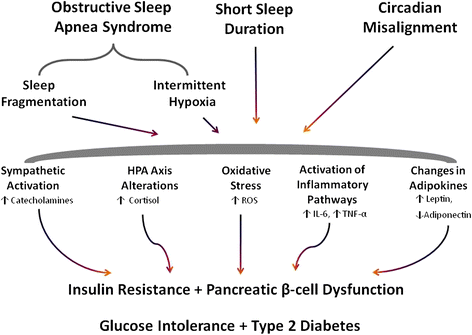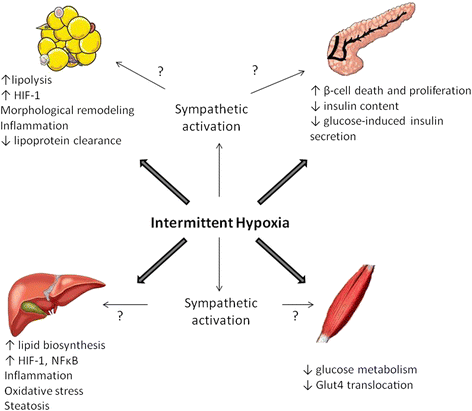The impact of sleep disorders on glucose metabolism: endocrine and molecular mechanisms
- PMID: 25834642
- PMCID: PMC4381534
- DOI: 10.1186/s13098-015-0018-3
The impact of sleep disorders on glucose metabolism: endocrine and molecular mechanisms
Abstract
Modern lifestyle has profoundly modified human sleep habits. Sleep duration has shortened over recent decades from 8 to 6.5 hours resulting in chronic sleep deprivation. Additionally, irregular sleep, shift work and travelling across time zones lead to disruption of circadian rhythms and asynchrony between the master hypothalamic clock and pacemakers in peripheral tissues. Furthermore, obstructive sleep apnea syndrome (OSA), which affects 4 - 15% of the population, is not only characterized by impaired sleep architecture but also by repetitive hemoglobin desaturations during sleep. Epidemiological studies have identified impaired sleep as an independent risk factor for all cause of-, as well as for cardiovascular, mortality/morbidity. More recently, sleep abnormalities were causally linked to impairments in glucose homeostasis, metabolic syndrome and Type 2 Diabetes Mellitus (T2DM). This review summarized current knowledge on the metabolic alterations associated with the most prevalent sleep disturbances, i.e. short sleep duration, shift work and OSA. We have focused on various endocrine and molecular mechanisms underlying the associations between inadequate sleep quality, quantity and timing with impaired glucose tolerance, insulin resistance and pancreatic β-cell dysfunction. Of these mechanisms, the role of the hypothalamic-pituitary-adrenal axis, circadian pacemakers in peripheral tissues, adipose tissue metabolism, sympathetic nervous system activation, oxidative stress and whole-body inflammation are discussed. Additionally, the impact of intermittent hypoxia and sleep fragmentation (key components of OSA) on intracellular signaling and metabolism in muscle, liver, fat and pancreas are also examined. In summary, this review provides endocrine and molecular explanations for the associations between common sleep disturbances and the pathogenesis of T2DM.
Keywords: Diabetes; Insulin resistance; Intermittent hypoxia; Metabolic syndrome; Obesity; Obstructive sleep apnea; Shift working; Sleep.
Figures


References
-
- Kripke DF, Simons RN, Garfinkel L, Hammond EC. Short and long sleep and sleeping pills. Is increased mortality associated? Arch Gen Psychiatry. 1979;36:103–16. - PubMed
-
- Schoenborn CA, Adams PE. Health behaviors of adults: United States, 2005–2007. Vital Health Stat 10. 2010;245:1–132. - PubMed
-
- Centers for Disease Control and Prevention Short Sleep Duration Among Workers — United States, 2010. Morb Mortal Wkly Rep. 2012;61:281–5. - PubMed
LinkOut - more resources
Full Text Sources
Other Literature Sources

